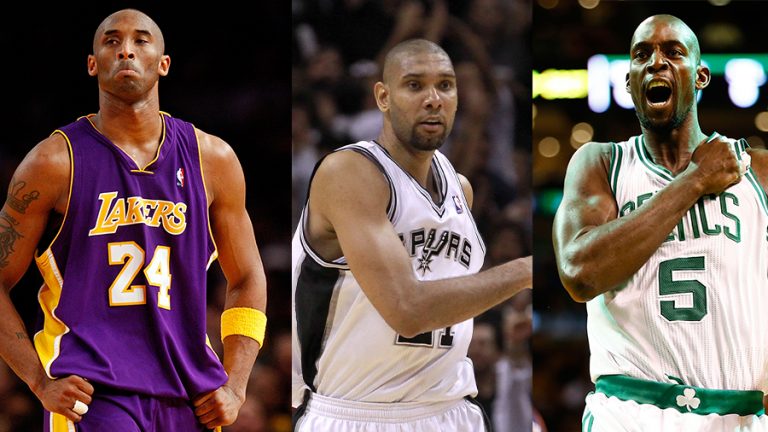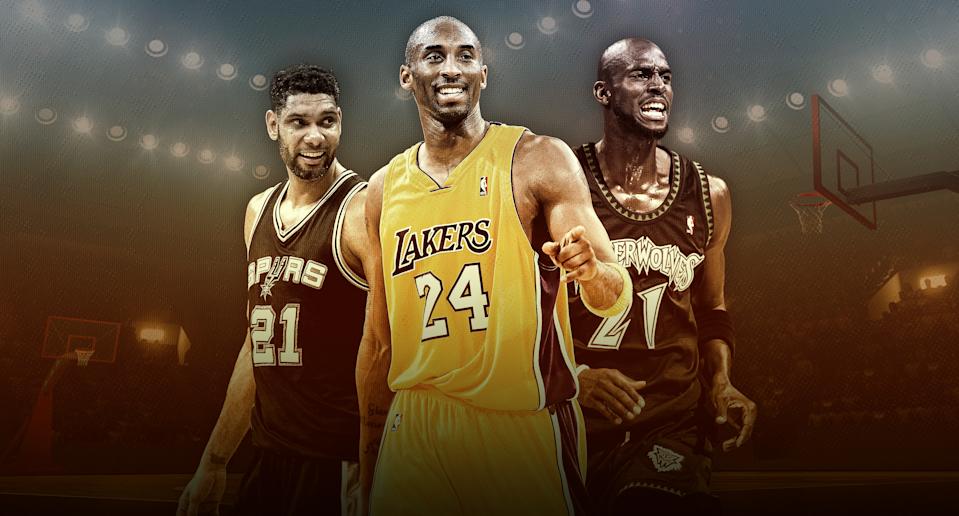
This year’s Basketball Hall of Fame class is incredible from top to bottom, but its three NBA headliners — Kobe Bryant, Tim Duncan and Kevin Garnett — represent one of the greatest trios of players ever to get inducted together. As a trio, these guys dominated the post-Michael Jordan landscape and propelled professional basketball into the 21st century.
Consider these two facts:
- From 1999 to 2010, Duncan, Bryant and Garnett combined to win 10 of the 12 NBA titles. The exceptions were 2003-04 (Pistons) and 2005-06 (Heat).
- Only six NBA players have made the All-Star team at least 15 times. Bryant, Duncan and Garnett are three of them. The other three? Kareem Abdul-Jabbar, Shaquille O’Neal and LeBron James.
Together they lead one of the greatest Hall of Fame classes ever, making Saturday’s induction ceremony (5:30 p.m. ET on ESPN and the ESPN App) a must-watch. But as impressive as this trio is collectively, each became a Hall of Famer for different reasons individually. Let’s dive into each star’s résumé and examine his signature moves, starting with the late, great Kobe Bryant.

Kobe Bryant
He gave his all of fame speech in a film,
https://youtu.be/_pDxGtijWZs?t=18
https://youtu.be/1A_R4t2vRE4?t=19
Simply put, Bryant was one of the best players to ever play the sport. He could do it all, but his scoring prowess sticks out. By the time he retired, Bryant had scored more points than all but two other players in league history.
If there’s one signature play that epitomizes Bryant’s game, it happened in the first round of the 2006 playoffs against the Phoenix Suns.
Bryant could score in every way imaginable, but his unassisted midrange jumpers were the foundation of his game; he could create his own jumpers any time he wanted or needed to. He wasn’t a great shooter at the beginning of his career, but over time he built one of the most comprehensive jump-shooting arsenals in league history.
His creativity in getting to his shot was off the charts. His physical ability was second to none, helping him generate clean jumpers no matter who was defending him. His mechanics were underrated; no matter how he got into a jump shot — with a spin move, a fadeaway or a pull-up — his release was impeccable. Bottom line: Like his hero, Michael Jordan, he was not only unstoppable in the midrange but also beautiful to watch.
But Bryant was more than just a bucket. His famous Mamba Mentality — that willful determination of his — also made him one of the most terrifying crunch-time players we will ever see. You could see it in his eyes. You could see it on the floor. Those things all came together in that moment against the Suns in the 2006 playoffs.
Who can forget it? Down one point with a few seconds remaining, Bryant grabbed a Luke Walton tip off a jump ball just beyond the midcourt line. He used his dribble to weave his way through the teeth of the Phoenix defense, got to the right elbow, rose up and hit one of the most cold-blooded buzzer-beaters in postseason history.
From the moment he got the ball, everyone in the gym and at home knew he was going to shoot it. That didn’t matter.
Bryant’s legendary blend of talent, competitiveness, bravado and aesthetic magnificence combined to forge one of the greatest legacies this sport will ever know. Nobody wanted it more than Bryant, and his résumé proves it.
Signature Shots: Kobe’s unassisted midrange jumper
Kirk Goldsberry explores Kobe Bryant’s legendary scoring prowess and the Mamba’s gorgeous unassisted midrange jump shot.
Tim Duncan
Duncan is known as the greatest power forward to ever play the sport for good reason. The unassuming Big Fundamental won two MVPs and made the All-NBA and All-Defensive teams 15 times. It was the combination of his generational talent, his professionalism and his sustainability that enabled him to become the cornerstone of one of the league’s greatest modern dynasties.
Duncan’s low-key demeanor kept him out of the headlines, but his contributions on the court kept the Spurs near the top of the NBA for nearly two decades. Between 1999-2000 and 2016-17, the Spurs won 50 or more games in every season. That’s an NBA record that might never get broken. Duncan led his team to the playoffs 18 times, to the Finals six times and to the title five times.
Those numbers would be great in any era, but they are even more remarkable in the context of a 21st-century NBA teeming with rich talent. Just think about the players and teams Duncan had to compete with for those titles. Over the years, he accumulated postseason series wins over Bryant, Garnett, O’Neal, James, Dwyane Wade, Steve Nash, Dirk Nowitzki, Kevin Durant and Stephen Curry.
Between 1998 and 2016, he played in 251 total playoff games — more than the equivalent of three full regular seasons — averaging 20.6 points and 11.4 rebounds per game. Only one player in league history has logged more playoff minutes than Duncan did: LeBron James.
Duncan’s signature shot aligned perfectly with his nature. His bank shot from the left block was fundamentally sound and relentlessly effective.
This example sums it up perfectly. Duncan would back his man down, threaten the middle of the court, then spin back toward the baseline and hit that bank shot.
Duncan was a phenomenal post player. He could face you up or back you down. He could hurt you from either block. Over either shoulder. With either hand. He could patiently wait for an opening or pounce when given an inch. For almost two decades, Duncan had some of the best big-man footwork this league has ever seen. He had incredible balance for his size. He had every big-man trick in his bag — inside pivots, reverse pivots, step-throughs, up-and-unders — and he knew when to use all of them based on the situation. But there’s something about that bank shot that we will remember forever.
The NBA didn’t begin tracking data on bank shots until Duncan’s seventh season, but the numbers are still staggering. In that time he made nearly 1,200 bank shots; no other player has even attempted 1,000.
Still, all those bank shots were available for one simple reason: Defenders were terrified of Duncan’s ability to blow by them and get easy buckets near the rim, especially early in his career, when he was one of the quickest big men in the league. As he aged, Duncan lost some of his quickness, but his savvy and that bank shot still enabled him to be effective in the low post.
Half geometry, half basketball poetry, the bank was always open when Duncan was posting up his defender, no matter who it was.
Signature Shots: Tim Duncan’s legendary post moves
Kevin Garnett
Like Bryant, Garnett came straight into the NBA from high school, and that “prep-to-pros” leap remains a huge part of his legacy. He defied expectations and thrived in the NBA despite a fleet of prominent skeptics who doubted he could succeed without playing college basketball first. Like Duncan, Garnett became one of the best two-way big men this league has ever seen. Consider these two nuggets:
- The Big Ticket is one of five players in league history to win both an MVP and a Defensive Player Of The Year Award.
- Only three players in NBA history have 25,000 points, 10,000 rebounds and 5,000 assists: Kareem Abdul-Jabbar, Karl Malone and Kevin Garnett.
The modern NBA is full of big players capable of stretching out defenses and knocking down long jumpers, but when Garnett entered the NBA in 1996, that was a rarity. Along with players like Dirk Nowitzki and Rasheed Wallace, Garnett helped change the game by proving that big players could threaten defenses from distance.
Garnett’s feathery touch as a shooter helped his teams immensely. He was a versatile scorer, but his ability to shoot in the midrange was unprecedented for a player of his size and athleticism. No big man in league history merged physical ability and shooting skill like Garnett. He could move like a guard, but at 6-11 he could also shoot over virtually any defender in the NBA.
In Boston, when he played alongside other great scorers such as Paul Pierce and Ray Allen, Garnett became one of the NBA’s best pick-and-roll partners. He set screens as well as anyone, freeing up a ballhandling teammate before sliding into open space and knocking down 20-footers.
Garnett’s ability to hit those shots opened up the paint for teammates such as Pierce and Rajon Rondo. Garnett’s prowess from distance forced opposing bigs to defend him far away from the basket, effectively taking rim protectors away from the hoop.
Those Celtics teams had incredible defenses, thanks in large part to Garnett, and since he spent so much time at the top of the arc on offense, his commute back on defense was shorter, enabling him to protect the rim and slow down opponents in transition.
And that’s the thing about all three of these guys. Yes, they were all phenomenal scorers, but they wouldn’t be the legends they are now if they weren’t also incredible defenders. Three players in NBA history have been named to the All-Defensive Team at least 12 times: Tim Duncan (15), Kobe Bryant (12) and Kevin Garnett (12).
All three of them got buckets, combining for 99,623 points between the regular season and the playoffs. But all three of them won games on defense too, each playing D at elite levels for well over a decade. While many elite scorers throughout history took it easy on the less glamorous end of the court, these fellas did the opposite. It’s a testament to their collective professionalism and their commitment to their teammates. While scoring gets you headlines and All-Star nods, defense wins championships, and that’s something all three of these inductees proved throughout their legendary caree
Signature Shots: KG’s silky jump shot
Kirk Goldsberry breaks down Kevin Garnett’s silky jumper, which helped pave the way for the NBA’s modern stretch bigs.

